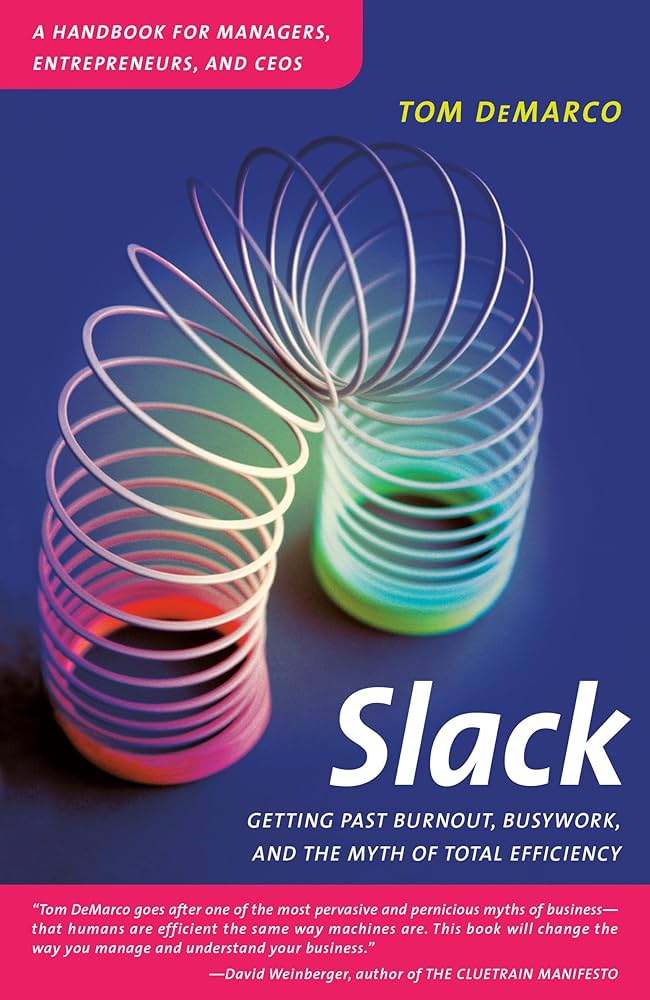
Slack: Getting Past Burnout, Busywork, and the Myth of Total Efficiency by Tom DeMarco is a well-regarded book in the field of management and organizational behavior first published in 2001.
DeMarco challenges the conventional wisdom that companies must maximize efficiency at all costs. He argues that an obsession with efficiency can lead to a work environment that lacks the slack necessary for innovation, flexibility, and the maintenance of employee well-being.
The book advocates for creating slack within organizations to allow for recovery, learning, and innovation. DeMarco suggests that by allowing some degree of slack, organizations can improve their adaptability, employee satisfaction, and ultimately, their long-term performance.
"Slack" is not just a critique of the relentless pursuit of efficiency but also a practical guide to creating a more humane and effective workplace. It's a must-read for managers and leaders who want to foster an environment where innovation and creativity can thrive, without sacrificing the well-being of their employees.
Slack
DeMarco delves into the counterintuitive idea that efficiency, often seen as the ultimate goal in business, can actually be detrimental to an organization's health and long-term success if pursued without understanding the value of slack.
Slack is defined as the degree of freedom in a company that allows it to change. It represents the buffer or cushion that provides the space for people to innovate, to recover from setbacks, and to prepare for future challenges without being constantly overburdened.
The Problem with "Total Efficiency"
DeMarco argues that when organizations strive for 100% efficiency, they eliminate slack, leaving no room for recovery, creativity, or responsiveness to unexpected events. This can lead to burnout, decreased employee morale, and a brittle organization that can't adapt to change.
Benefits of Slack
By allowing for slack, organizations can foster an environment where employees have the time and space to think creatively, pursue new ideas, and maintain a healthier work-life balance. Slack enables resilience, allowing teams to absorb disturbances and adapt to changes more effectively.
Managing for Slack
DeMarco discusses strategies for managing slack in a way that balances the need for efficiency with the need for flexibility and innovation. This includes understanding the trade-offs between being optimally efficient in the short term and remaining adaptable and innovative for long-term success.
Change and Growth
It is a compelling argument for the strategic value of slack in ensuring organizations are not just efficient but also adaptable, innovative, and poised for growth. It challenges traditional notions of productivity and efficiency by showing how they can actually hinder change and long-term success if not balanced with adequate slack.
The Dynamics of Change
DeMarco discusses how organizations often face resistance to change, partly due to the lack of slack. Without slack, employees are too stretched to adapt to new processes or to innovate. He argues that for change to be embraced, organizations need to ensure there's enough slack for employees to experiment and learn from new experiences.
Growth Through Learning
This section emphasizes the importance of learning as a fundamental component of growth. DeMarco suggests that slack is crucial for learning; it provides the space and time necessary for employees to acquire new skills and knowledge, which, in turn, prepares the organization for future challenges and opportunities.
Innovation as a Product of Slack
Innovation requires the freedom to think creatively, experiment, and sometimes fail. DeMarco illustrates how a lack of slack stifles innovation by not allowing the necessary room for these activities. By incorporating slack, organizations can foster a culture of innovation that supports long-term growth.
Managing Change
DeMarco offers insights into managing change within an organization, highlighting the importance of communication, flexibility, and support structures. He points out that managing change effectively requires acknowledging the human aspect of transitions and providing employees with the resources and time they need to adjust.
Sustainability and Resilience
The discussion extends to how slack contributes to an organization's sustainability and resilience. By not operating at maximum capacity at all times, organizations can more easily absorb shocks and adapt to unforeseen changes, thereby ensuring long-term viability.
Strategic Application of Slack
DeMarco concludes with advice on strategically implementing slack within organizations to support change and growth. This involves making deliberate decisions about where and how slack is allocated, ensuring that it aligns with the organization's goals and values.
Risk and Risk Management
By integrating slack into their risk management practices, organizations can navigate uncertainties more effectively and position themselves for long-term success.
This section delves into how embracing slack can be a strategic approach to managing risk and ensuring an organization's resilience and adaptability in the face of uncertainty.
Understanding Risk
DeMarco begins by defining what risk means in the context of an organization. He explains that risk is inherent in all business activities and decisions, particularly those involving change and innovation. Understanding the types of risks an organization faces is the first step toward managing them effectively.
The Role of Slack in Risk Management
DeMarco argues that slack plays a crucial role in risk management by providing the buffer needed to absorb and respond to unforeseen events or outcomes. Slack allows organizations the flexibility to experiment and take calculated risks without jeopardizing their core operations. It's this capacity for absorption and adaptation that makes slack a key component in risk management strategies.
Balancing Risk and Efficiency
One of the central themes in this part is the balance between risk management and the pursuit of efficiency. DeMarco critiques the tendency of organizations to prioritize efficiency to the point where they become brittle and unable to manage risks effectively. He advocates for a balanced approach that recognizes the value of slack in creating a more resilient and agile organization.
Strategies for Managing Risk
DeMarco provides practical advice on managing risk, emphasizing the importance of diversification, contingency planning, and fostering a culture that is open to discussing and addressing risks. He suggests that effective risk management involves not only identifying and mitigating risks but also preparing for the possibility of failure and learning from it.
Innovation and Risk Taking
The section also explores the relationship between innovation, risk-taking, and slack. DeMarco posits that innovation requires a willingness to take risks and that organizations must cultivate an environment where such risks are supported by adequate slack. This includes allowing for failures and viewing them as learning opportunities rather than purely negative outcomes.
Implementing Risk Management Practices
Lastly, DeMarco discusses how organizations can implement risk management practices that incorporate slack. This involves setting aside resources, including time and financial reserves, to deal with potential risks and ensuring that the organization's approach to risk management aligns with its overall strategy and values.
TL;DR
DeMarco challenges the conventional wisdom that maximizing efficiency at all costs is the key to success. Instead, he argues that a certain amount of slack, or uncommitted time within an organization's schedule, is essential for creativity and the ability to respond to unexpected changes.
DeMarco outlines how excessive focus on efficiency can lead to burnout and reduce the quality of work, as employees are pushed to their limits without room for recovery or creative thinking. He suggests that by allowing for slack, organizations can improve the resilience and adaptability of their teams, leading to better long-term results. The book covers strategies for managers to introduce slack into their teams, reevaluate priorities, and encourage a healthier, more productive work environment that balances the need for efficiency with the human need for flexibility and growth.
